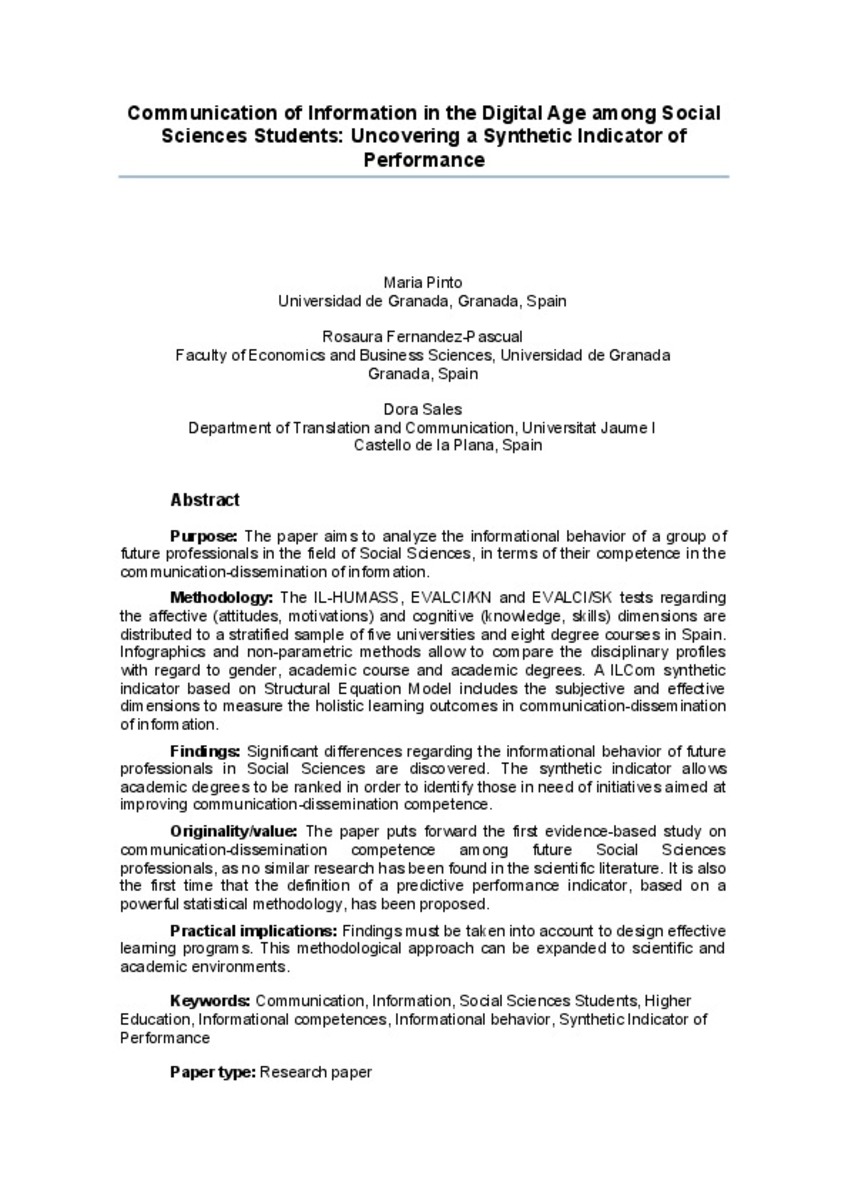Mostrar el registro sencillo del ítem
Communication of information in the digital age among social sciences students: Uncovering a synthetic indicator of performance
| dc.contributor.author | Pinto Molina, María | |
| dc.contributor.author | Fernández Pascual, Rosaura | |
| dc.contributor.author | Sales, Dora | |
| dc.date.accessioned | 2018-11-20T08:16:10Z | |
| dc.date.available | 2018-11-20T08:16:10Z | |
| dc.date.issued | 2018 | |
| dc.identifier.citation | PINTO, Maria; FERNANDEZ-PASCUAL, Rosaura; SALES, Dora. Communication of information in the digital age among social sciences students: Uncovering a synthetic indicator of performance. Aslib Journal of Information Management, 2018, vol. 70, no 4, p. 326-343 | ca_CA |
| dc.identifier.issn | 2050-3806 | |
| dc.identifier.uri | http://hdl.handle.net/10234/177573 | |
| dc.description.abstract | Purpose: The purpose of this paper is to analyze the informational behavior of a group of future professionals in the field of social sciences (SS), in terms of their competence in the communication–dissemination of information. Design/methodology/approach: The IL-HUMASS, EVALCI/KN and EVALCI/SK tests regarding the affective (attitudes, motivations) and cognitive (knowledge, skills) dimensions are distributed to a stratified sample of five universities and eight degree courses in Spain. Infographics and non-parametric methods allow to compare the disciplinary profiles with regard to gender, academic course and academic degrees. An Information Literacy Communication synthetic indicator based on structural equation modeling includes the subjective and effective dimensions to measure the holistic learning outcomes in communication–dissemination of information. Findings: Significant differences regarding the informational behavior of future professionals in SS are discovered. The synthetic indicator allows academic degrees to be ranked in order to identify those in need of initiatives aimed at improving communication–dissemination competence. Practical implications: Findings must be taken into account to design effective learning programs. This methodological approach can be expanded to scientific and academic environments. Originality/value: The paper puts forward the first evidence-based study on communication–dissemination competence among future SS professionals, as no similar research has been found in the scientific literature. It is also the first time that the definition of a predictive performance indicator, based on a powerful statistical methodology, has been proposed. | ca_CA |
| dc.format.extent | 18 p. | ca_CA |
| dc.format.mimetype | application/pdf | ca_CA |
| dc.language.iso | eng | ca_CA |
| dc.publisher | Emerald | ca_CA |
| dc.relation.isPartOf | Aslib Journal of Information Management, 2018, vol. 70, no 4 | ca_CA |
| dc.rights | © Copyright Emerald Publishing Limited | ca_CA |
| dc.rights.uri | http://rightsstatements.org/vocab/InC/1.0/ | * |
| dc.subject | information | ca_CA |
| dc.subject | higher education | ca_CA |
| dc.subject | communication | ca_CA |
| dc.title | Communication of information in the digital age among social sciences students: Uncovering a synthetic indicator of performance | ca_CA |
| dc.type | info:eu-repo/semantics/article | ca_CA |
| dc.identifier.doi | https://doi.org/10.1108/AJIM-02-2018-0035 | |
| dc.rights.accessRights | info:eu-repo/semantics/openAccess | ca_CA |
| dc.relation.publisherVersion | https://www.emeraldinsight.com/doi/full/10.1108/AJIM-02-2018-0035 | ca_CA |
| dc.contributor.funder | Spanish Ministry of Science and Innovation (MINECO): EDU2011-29290 | ca_CA |
| dc.type.version | info:eu-repo/semantics/updatedVersion | ca_CA |
Ficheros en el ítem
Este ítem aparece en la(s) siguiente(s) colección(ones)
-
TRAD_Articles [342]
Articles de publicacions periòdiques







